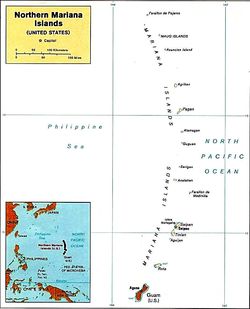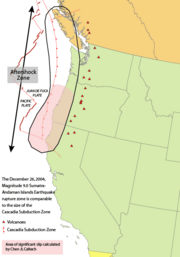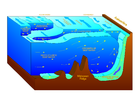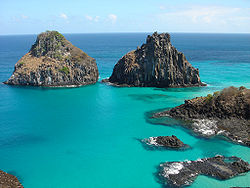Volcanic arc

A volcanic arc is a chain of volcanoes parallel to a mountain belt positioned in an arc shape in map view. In case the volcanoes are positioned offshore, we speak of a volcanic island arc. Generally, they are formed as an oceanic tectonic plate subducts under another tectonic plate and produces magma at depth under the over-riding plate. The magma ascends to form an arc of volcanoes parallel to the subduction zone.
There are therefore two types of volcanic arcs: oceanic arcs (which are a special (volcanic) type of island arcs, a type of archipelago), and continental volcanic arcs, the volcanic type of what is generally called an arc-shaped mountain belt. In the former, oceanic crust subducts beneath other oceanic crust on an adjacent plate, while in the latter case the oceanic crust subducts beneath continental crust. In some situations, a single subduction zone may show both aspects along its length, as part of a plate subducts beneath a continent and part beneath adjacent oceanic crust.
The term volcanic arc is often confused with the term island arc. As also discussed on the page dedicated to island arc's, both are related to arc shape mountain belts. The first one is simply offshore and showing a series of islands, but is not necessary composed of merely volcanous, whereas the second one is a series of volcanous, but not necessary offshore. Bothe terms should, therefore, be used, but taking care of their exact meaning.
Furthermore, it must be noted that volcanic activity and volcanous are present in almost any mountain belt, not always developed as an arc shaped feature, but often present as isolated, but sometimes impressively huge volcanous (such as the Vesuvius or the Etna volcanous in Italy, part of separate different kind of intramontanous volcanic ensembles).
The active front of a volcanic arc is the belt where volcanism develops at a given time. Active fronts may move over time changing their distance to the oceanic trench as well as their width.
Contents |
Petrology
In the subduction zone, loss of water from the subducted slab induces partial melting of the overriding mantle and generates low-density, calc-alkaline magma that buoyantly rises to intrude and be extruded through the lithosphere of the overriding plate. This loss of water is due to the destabilization of the mineral chlorite at approximately 40-60 km depth.[1][2] This is the reason for island arc volcanism at consistent distances from the subducting slab: because the temperature-pressure conditions for flux-melting volcanism due to chlorite destabilization will always occur at the same depth, the distance from the trench to the arc volcanoes is determined only by the dip angle of the subducting slab.
On the subducting side of the island arc is a deep and narrow oceanic trench, which is the trace at the Earth’s surface of the boundary between the downgoing and overriding plates. This trench is created by the gravitational pull of the relatively dense subducting plate pulling the leading edge of the plate downward. Multiple earthquakes occur along this subduction boundary with the seismic hypocenters located at increasing depth under the island arc: these quakes define the Wadati-Benioff zones.
Ocean basins that are being reduced by subduction are called 'remnant oceans' as they will slowly be shrunken out of existence and crushed in the subsequent orogenic collision. This process has happened over and over in the geologic history of the Earth.
In the rock record, volcanic arcs can be seen as the volcanic rocks themselves, but because volcanic rock is easily weathered and eroded, it is more typical that they are seen as plutonic rocks, the rocks that formed underneath the arc (e.g. the Sierra Nevada batholith), or in the sedimentary record as lithic sandstones.
 Cascade Volcanic Arc, a continental volcanic arc |
 The Aleutian Arc, with both oceanic and continental parts. |
Examples
Two classic examples of oceanic island arcs are the Mariana Islands in the western Pacific Ocean and the Lesser Antilles in the western Atlantic Ocean. The Cascade Volcanic Arc in western North America and the Andes along the western edge of South America are examples of continental volcanic arcs. The best examples of volcanic arcs with both sets of characteristics are in the North Pacific, with the Aleutian Arc consisting of the Aleutian Islands and their extension the Aleutian Range on the Alaska Peninsula, and the Kuril-Kamchatka Arc comprising the Kuril Islands and southern Kamchatka Peninsula.
Continental arcs
- Cascade Volcanic Arc
- Alaska Peninsula and Aleutian Range
- Kamchatka
- Andes
- North Volcanic Zone
- Central Volcanic Zone
- South Volcanic Zone
- Austral Volcanic Zone
- Central America Volcanic Arc
Island arcs
- Aleutian Islands
- Kuril Islands
- Northeastern Japan arc
- Japan and Ryukyu Islands
- Izu-Bonin-Mariana Arc:
- Izu Islands
- Bonin Islands
- Mariana Islands
- Philippines
- Tonga and Kermadec Islands
- Andaman and Nicobar Islands
- Mentawai Islands
- Sunda Arc
- Lesser Sunda Islands
- Tanimbar and Kai Islands
- Solomon Islands
- South Aegean Volcanic Arc
- Egean, or Hellenic arc
- Lesser Antilles, including the Leeward Antilles
- Scotia Arc:
- Mascarene Islands
Ancient Island arcs
- Insular Islands
- Intermontane Islands
- Sakhalin island arc
See also
- Back-arc basin
- Volcanic belt
- Island arc
References
- ↑ Grove, T. L., N. Chatterjee, S. W. Parman, and E. Médard (2006), The Influence of H2O on Mantle Wedge Melting, Earth and Planetary Science Letters, 249, 74-89.
- ↑ Grove, T.L., C. B. Till, N. Chatterjee, and E. Médard (submitted 2008), Transport of H2O in subduction zones and its role in the formation and location of arc volcanoes, Nature.
- Subduction Zone Volcanism
- Tectonics and Volcanoes of Japan
- USGS: Island-Arc, Oceanic, and Continental Volcanoes
|
||||||||||||||
|
||||||||||||||||||||||||||||||||||||||||||
|
|||||||||||||||||||



